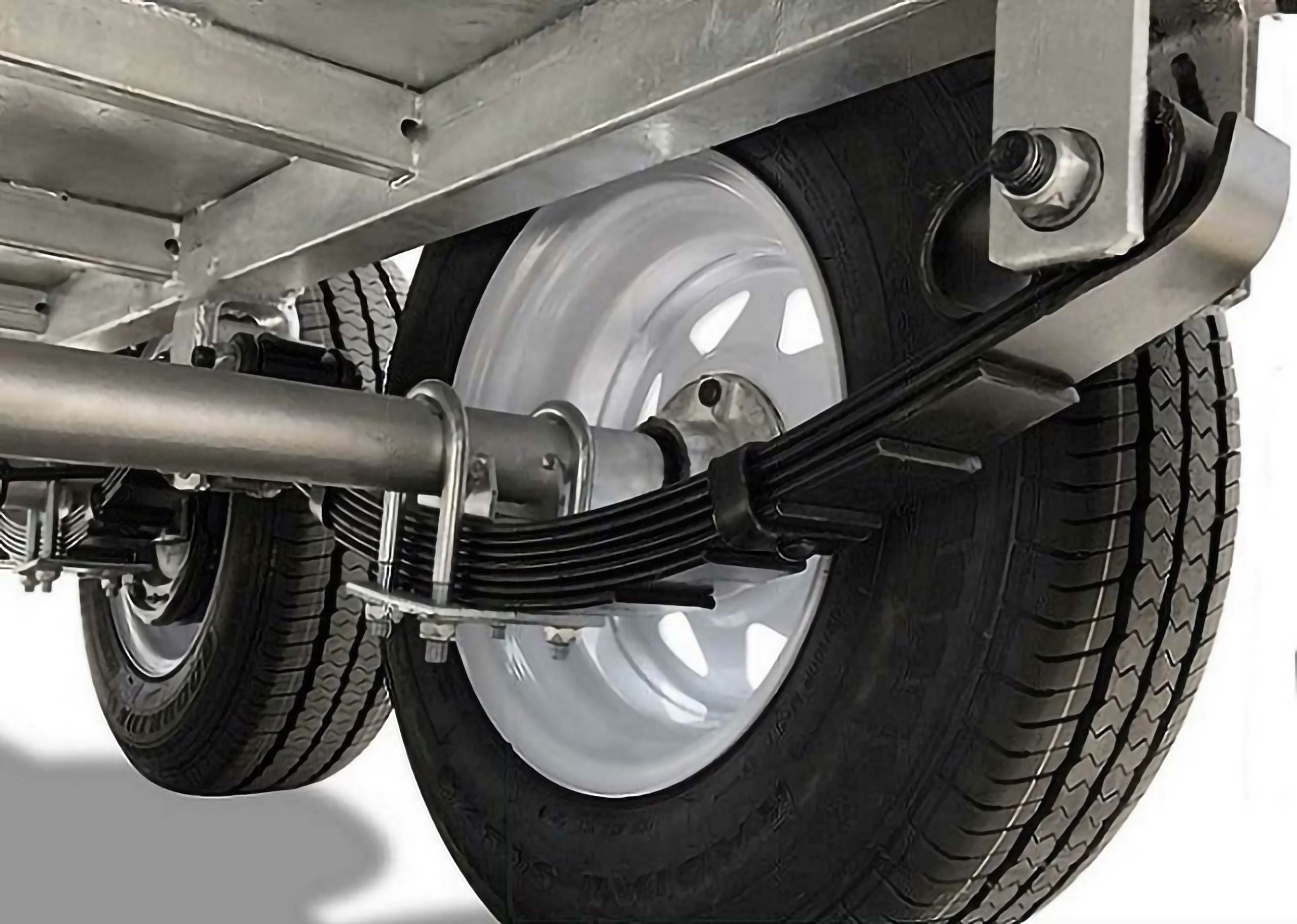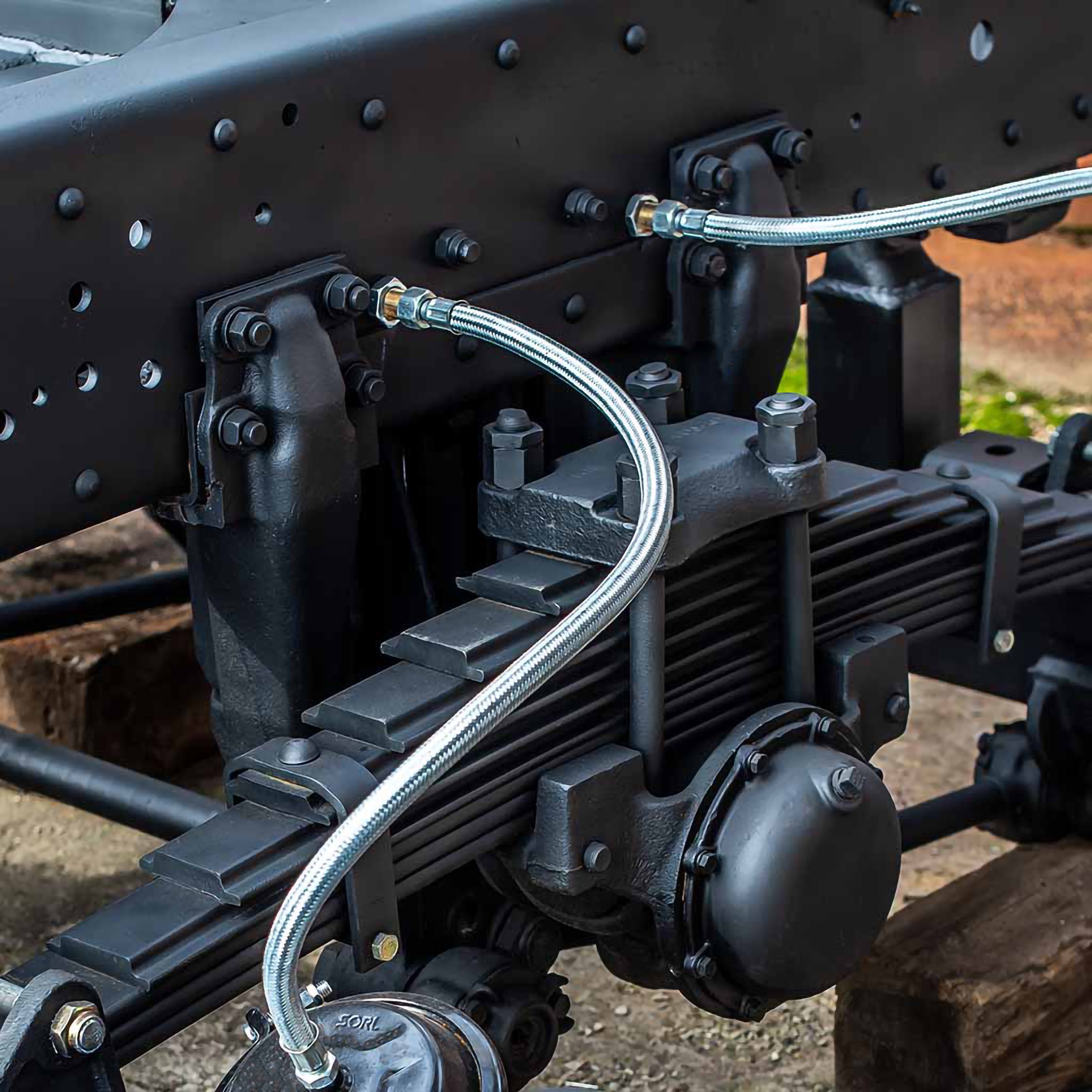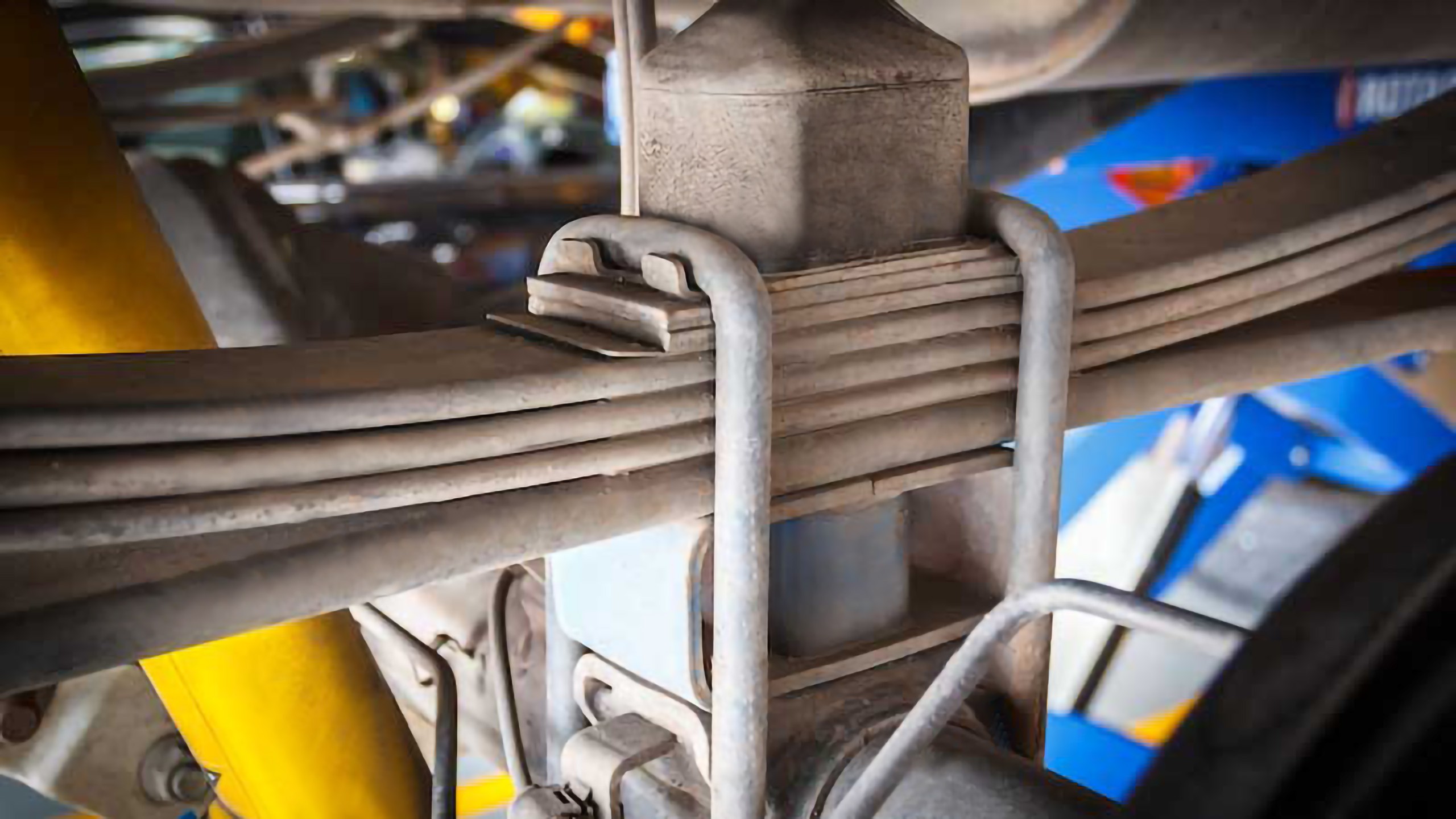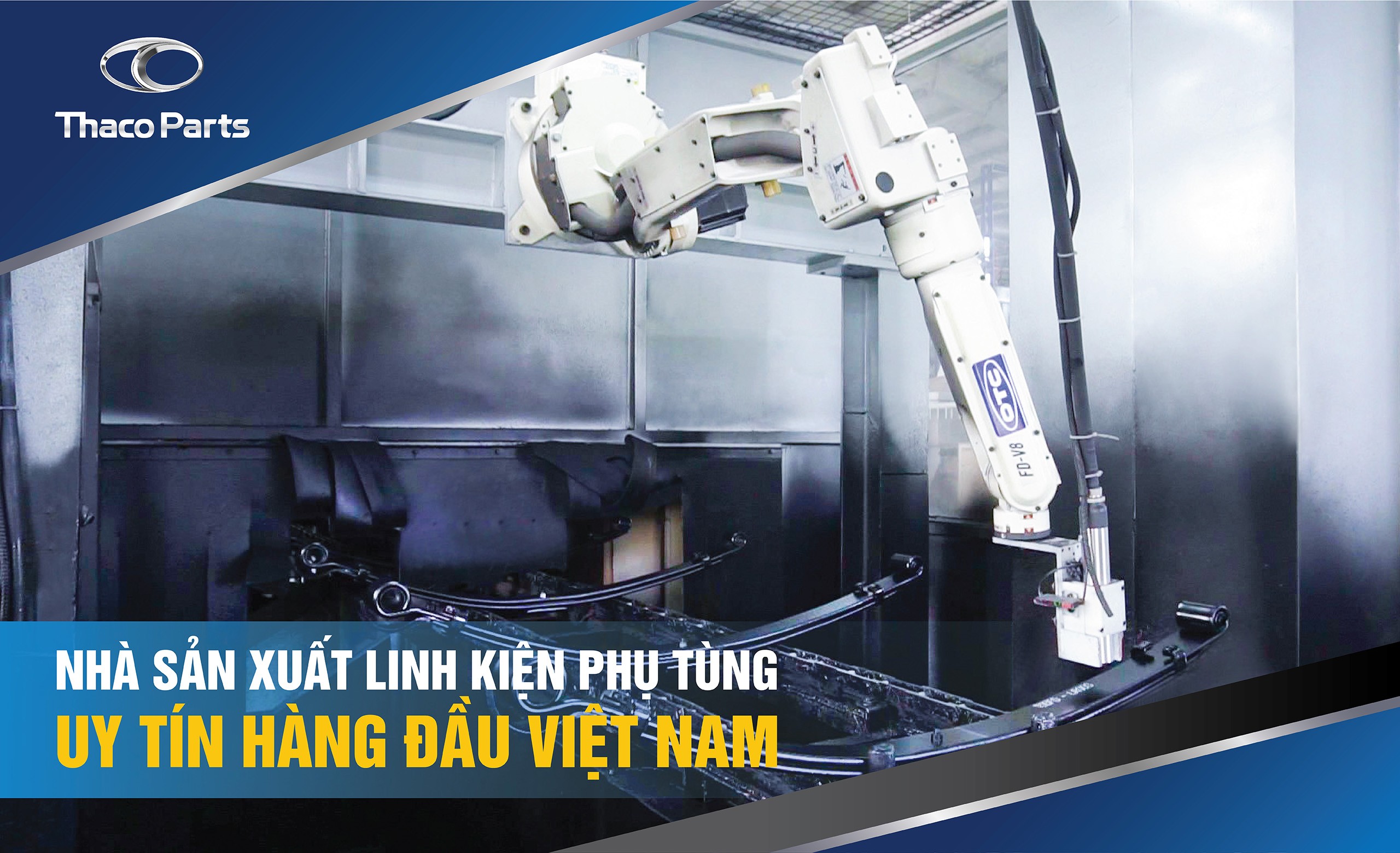Leaf springs in trucks are a crucial part of the suspension system, directly impacting the smoothness and stability of operation, especially when carrying heavy loads. Understanding the structure of leaf spring systems in trucks not only helps you operate your vehicle more safely but also enables you to make accurate maintenance and repair decisions, saving costs. This article from Xe Tải Mỹ Đình experts will delve into the detailed structure, classification, and operating principles of leaf spring systems, providing you with the most comprehensive and useful knowledge.
Overview of Truck Leaf Spring Systems
The leaf spring system on trucks, an indispensable component of the suspension system, plays the role of reducing shocks and vibrations from the road surface transmitted to the chassis. The main function of leaf springs is to absorb impact forces when the vehicle moves on bumpy, potholed roads, or during sudden braking, helping the vehicle maintain balance, stability, and providing a smooth driving experience for the driver while protecting goods on board.
Truck leaf springs are typically constructed from multiple elastic steel leaves joined together, forming a spring pack with high load-bearing and elasticity capabilities. The number of leaves and their thickness determine the load-bearing capacity of the leaf spring system.
 Truck leaf spring as part of the suspension system, primarily responsible for shock absorption for smooth operation
Truck leaf spring as part of the suspension system, primarily responsible for shock absorption for smooth operation
Detailed Structure of Truck Leaf Spring Systems
To better understand the importance of leaf springs, we need to delve into the structure of leaf spring systems in trucks. A complete leaf spring system includes the following main components:
1. Leaf Springs
Leaf springs are the core components determining the load-bearing and shock-absorbing capacity of the system. They are made from high-grade elastic alloy steel, undergoing a special heat treatment process to achieve optimal hardness and ductility.
- Shape and Size: Leaf springs have a certain curved shape (usually elliptical or parabolic) and varying lengths. Shorter leaves are usually on top, while the longest leaf (main leaf) is at the bottom, responsible for bearing the main load.
- Number of Leaves: The number of leaves in a spring pack depends on the designed load capacity of the vehicle. Heavy-duty trucks typically have more leaves to increase load-bearing capacity.
- Leaf Spring Surface: The surfaces of the leaves are treated to reduce friction between them as they move relative to each other during vehicle operation.
2. Leaf Spring Bushings
Leaf spring bushings are components made of rubber or polyurethane, placed at the connection points between the leaf spring and the chassis, or between the leaves.
- Function: Leaf spring bushings play a role in damping and absorbing vibrations, while also reducing friction and noise generated when the leaf spring moves. They also help increase the lifespan of metal parts by limiting direct contact and wear.
- Location: Bushings are installed at the front and rear of the spring pack, where the leaf spring is attached to the chassis and U-bolts.
3. Leaf Spring Bolts (Center Bolts & U-bolts)
Leaf spring bolts are specialized bolts that play the role of tightening and securing the leaves together into a pack and attaching the spring pack to the axle.
- Center Bolt: The center bolt passes through holes in the center of the leaves, holding the leaves tightly and ensuring they do not shift. The bolt head is usually swaged or locked to prevent loosening.
- U-bolts: U-bolts are U-shaped, wrapping around the spring pack and axle, then tightened with nuts. U-bolts are responsible for firmly securing the spring pack to the axle.
4. Shackles
Shackles, also known as swing arms, are hinged connection components at one or both ends of the spring pack.
- Function: Shackles allow the leaf spring to oscillate up and down flexibly when the vehicle moves on uneven roads. They compensate for changes in the length of the leaf spring when it is compressed or extended, ensuring smooth suspension system operation.
- Structure: Shackles are usually flat steel bars with holes for bolts to connect to the chassis and leaf spring.
5. Shock Absorbers
Although leaf springs already have a certain shock-absorbing capability, to increase shock absorption efficiency and control oscillations, trucks are often equipped with additional shock absorbers.
- Function: Shock absorbers absorb and dampen excess oscillations of the leaf spring, helping the vehicle become more stable, especially when cornering or braking suddenly.
- Types of Shock Absorbers: Trucks typically use hydraulic shock absorbers or air shock absorbers, depending on the load capacity and operating requirements.
6. Other Auxiliary Components
In addition to the main components above, the leaf spring system may also include other auxiliary components such as:
- Rubber Pads: Placed between the leaves or between the leaf spring and the chassis to reduce friction and noise.
- Stabilizer bar: Helps reduce body roll when cornering, increasing stability.
 Leaf springs are advantageous due to their low cost, ease of repair, and maintenance
Leaf springs are advantageous due to their low cost, ease of repair, and maintenance
Classification of Truck Leaf Spring Systems
Based on structure and characteristics, truck leaf spring systems are classified into the following main types:
1. Leaf Spring
This is the most common type of leaf spring on trucks, especially medium and heavy-duty trucks.
- Advantages:
- Simple structure, easy to manufacture and repair.
- Low cost.
- Good load-bearing capacity.
- High durability.
- Disadvantages:
- Shock absorption capability is not as good as modern leaf spring types.
- Relatively heavy weight.
- Ride comfort is not as high as other leaf spring types.
2. Coil Spring
Coil springs are less common on trucks, often found on light trucks or pickup trucks at the front axle.
- Advantages:
- Compact size.
- Better shock absorption than leaf springs.
- Smoother operation.
- Disadvantages:
- Lower load-bearing capacity than leaf springs.
- More complex structure, difficult to repair.
- Higher production cost.
3. Air Spring
Air springs use compressed air to create elastic force, commonly equipped on high-end trucks, tractor-trailers, or buses.
- Advantages:
- Superior shock absorption, providing maximum smoothness.
- Adjustable ride height.
- Automatic load leveling.
- Disadvantages:
- Most complex structure among leaf spring types.
- Highest cost.
- Requires accompanying air compressor system.
- Difficult to repair and maintain.
4. Parabolic Spring
Parabolic springs are a variation of leaf springs, using fewer leaves and having a parabolic shape.
- Advantages:
- Reduced weight compared to traditional leaf springs.
- Reduced friction between leaves, increasing smoothness.
- Longer lifespan.
- Disadvantages:
- Higher cost than regular leaf springs.
- Load-bearing capacity may be lower than conventional leaf springs of the same size.
 Truck leaf spring operates based on the elasticity principle of steel
Truck leaf spring operates based on the elasticity principle of steel
Operating Principle of Truck Leaf Spring Systems
The basic operating principle of truck leaf spring systems is based on the elasticity of steel material. When the vehicle moves on a bumpy road, the wheels are subjected to impact forces from the road surface, which are transmitted through the axle and act on the leaf spring.
- Load Bearing Stage: The leaves bend under the action of force. Elastic steel absorbs impact energy and temporarily deforms.
- Elastic Stage: When the impact force decreases or disappears, the leaves return to their original shape due to elasticity. This process releases the absorbed energy, pushing the chassis up and down.
- Shock Absorption and Stability: The combination of leaf spring compression and extension, along with the support of shock absorbers (if any), helps absorb vibrations and minimize shocks transmitted to the chassis and cabin, providing smoothness and stability for the vehicle.
Signs of Damage and Maintenance of Truck Leaf Spring Systems
To ensure the leaf spring system operates effectively and safely, early detection of signs of damage and regular maintenance are extremely important.
Signs Requiring Leaf Spring Maintenance
- Vehicle vibrates strongly: When driving over rough or potholed roads, the vehicle vibrates more than usual.
- Strange noises from the suspension system: Squeaking, clanking noises occur when the vehicle moves.
- Bent, cracked, or broken leaf springs: Visual inspection reveals deformed or damaged leaf springs.
- Vehicle veers off course: The vehicle tends to pull to one side when driving straight or cornering.
- Uneven tire wear: One side of the tire wears faster than the other.
- Uneven vehicle height: One side of the vehicle is lower than the other.
Truck Leaf Spring Maintenance Procedure
The truck leaf spring maintenance procedure usually includes the following steps:
- Prepare tools: Car jack, wrenches, sockets, spanner, brush, lubricant oil, rags.
- General inspection: Inspect the condition of leaf springs, bolts, bushings, shackles, and other components.
- Clean leaf springs: Remove dirt and mud adhering to the leaf springs with a brush and rags.
- Lubricate: Lubricate the contact surfaces between the leaves, bushings, and pivots with specialized lubricant oil.
- Inspect and tighten bolts: Ensure leaf spring bolts are tightened to the correct torque.
- Inspect and replace bushings (if necessary): Rubber bushings can age and deteriorate over time.
- Inspect and replace leaf springs (if necessary): If bent, cracked, or broken leaf springs are detected, they need to be replaced promptly.
 Recognizing early signs for truck leaf spring maintenance is essential
Recognizing early signs for truck leaf spring maintenance is essential
Thaco Parts – High-Quality Truck Leaf Spring Component Solutions
To ensure the truck leaf spring system operates durably and safely, using genuine, high-quality components is extremely important. Thaco Parts, a leading manufacturer of automotive components and parts in Vietnam, is proud to offer OEM truck leaf spring products that meet international quality standards.
With years of experience and reputation, Thaco Parts is committed to providing customers with truck leaf spring products that offer:
- Superior Quality: Manufactured on modern technology lines, using high-quality materials, ensuring optimal durability and load-bearing capacity.
- Variety of Types: Providing a full range of leaf springs, parabolic springs, suitable for various truck models.
- Competitive Prices: Products are manufactured domestically, optimizing costs, providing reasonable prices.
- Professional Service: Experienced technicians, ready to advise and support customers in choosing and installing suitable truck leaf springs.
 Thaco Parts – Leading and reputable manufacturer of auto parts in Vietnam
Thaco Parts – Leading and reputable manufacturer of auto parts in Vietnam
The article above has provided detailed information about the structure of leaf spring systems in trucks, from overview, detailed structure, classification, operating principles to maintenance and component selection. Hopefully, this knowledge will help you better understand this important component and make informed decisions to ensure your truck always operates safely and efficiently. If you are looking for high-quality truck leaf spring components, please contact Thaco Parts immediately via hotline: 0235 356 7161 for the best advice and support.